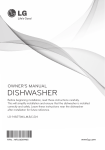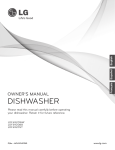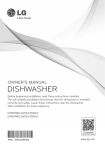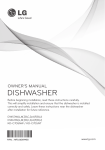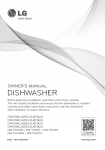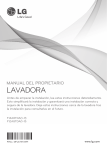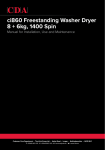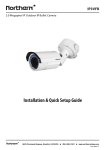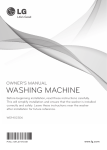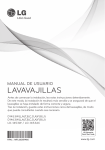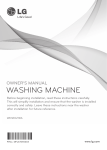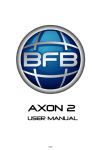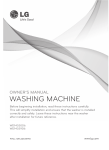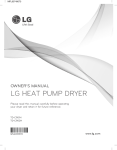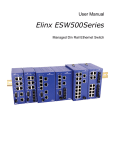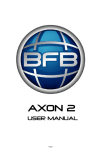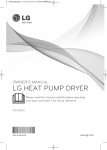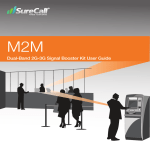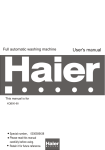Download DISHWASHER - Appliances Online
Transcript
OWNER'S MANUAL OWNER’S MANUAL DISHWASHER WASHING MACHINE Before beginning installation, read these instructions carefully. This will simplify installation and ensure that the dishwasher is installed correctly and safely. Leave these instructions the dishwasher Please read this manual carefully before near operating after for future your installation set and retain it forreference. future reference. LD-1481*4 WM0642H* P/NO : MFL31245123 MFL68741410 www.lg.com CONTENTS CONTENTS.................................2 Thank you for buying an LG Dishwasher. IMPORTANT SAFETY INSTRUCTIONS Please read your owner’s manual carefully, it provides instruction on safe installation, use and maintenance. Retain it for future reference. Important safety instructions............... 3 Read all instructions before use......... 4 Save these instructions....................... 5 INSTALLATION INSTRUCTIONS Prepare the installation opening ........ 7 Preparation for electrical wiring ......... 7 Preparing the dishwasher for installation...........................................8 Installing the dishwasher in its location...........................................8 Installation of drain hose..................... 9 Installation of water inlet hose.......... 10 Final check and assembling............. 10 How to level the dishwasher............. 10 Record the model and serial number of your Dishwasher. Model No. Serial No. Date of Purchase PARTS IDENTIFICATION......... 11 FUNCTION OF CONTROL BUTTONS.................................12 BEFORE USING FOR THE FIRST TIME Checking your water hardness level. . .... 14 Setting up the softening system level (hardness level) of your dishwasher....... 15 Salt filling..........................................16 Adding rinse aid................................ 17 USER MAINTENANCE & CLEANING INSTRUCTIONS Not used for a long time.................... 28 Cleaning the inside .......................... 28 Clean using white vinegar ................ 28 Filters................................................29 Upper spray arm............................... 30 Lower spray arm............................... 31 INFORMATION FOR ENERGY TEST.........................................18 HOW TO USE AND OPERATE Daily use load................................... 19 Cutlery basket................................... 20 Lower rack........................................21 Upper rack........................................21 Adding detergent.............................. 22 Refilling.............................................24 Select the programme...................... 25 Drying...............................................26 TROUBLE SHOOTING GUIDE Display code (condition code)........... 32 Display code (error code)................. 34 Washing problems............................ 35 Noise problems................................. 37 General problems............................. 38 Using SMARTDIAGNOSIS............... 40 SPECIFICATION ......................41 OPERATING SEQUENCE....... 27 2 IMPORTANT SAFETY INSTRUCTIONS READ ALL INSTRUCTIONS AND EXPLANATION OF THE INSTALLATION BEFORE USE WARNING For your safety, the information in this manual must be followed to minimize the risk of fire or explosion, electric shock, or to prevent property damage, injury to persons, or death. Your safety and the safety of others are very important. We have provided many important safety messages in this manual and on your appliance. Always read and obey all safety messages. This is the safety alert symbol. This symbol alerts you to potential hazards that can cause death or serious injury. All safety messages will follow the safety alert symbol and either the word DANGER, WARNING or CAUTION. These words mean: DANGER Death or serious injury will occur if the instructions are not strictly followed. WARNING Death or serious injury can occur if the instructions are not strictly followed. CAUTION You may be injured or cause damage to the product,if you do not follow instructions. All safety messages will tell you what the potential hazard is, tell you how to reduce the chance of injury, and tell you what can happen if the instructions are not followed. 3 IMPORTANT SAFETY INSTRUCTIONS Read all instructions before use WARNING To reduce the risk of fire, electric shock, or injury to persons when using the dishwasher, follow basic precautions, including the following: • Please read this manual carefully before using the dishwasher for the first time. • This manual contains very important notes regarding the installation, use and maintenance of your dishwasher. • The manufacturer can not be responsible for problems caused by ignoring these safety and caution instructions. • This dishwasher is designed for normal indoor, domestic household use. • Do not use the dishwasher for industrial or commercial use, or for anything other than domestic use. • The appliance is not intended for use by young children or infirm persons without supervision. • Check packaging and the dishwasher immediately for signs of transport damage. If the appliance is damaged, do not put it into use but contact your supplier without delay. • This appliance is intended to be used in household and similar applications such as; -S taff kitchen areas in offices and other non retail food working environments; -B y clients in holiday appartments and other residential type environments; • If this product is used for commercial or mobile purposes, it is not warranted. (Example: Public places such as restaurants, eateries or cafes, boats, mobile homes and caravans.) If the product is installed outside the normal service area, any cost of transportation involved in the repair of the product, or the replacement of a defective part, shall be borne by the owner. During installation • Electrical connection must be in accordance with the rating label. • Electrical safety is only guaranteed when the earth system of your house is in accordance with the related local regulations. (Do not use an extension cable or cord unless suited and approved by Australian Standards.) • If the hot water exceeds 65ºC, adjust the water heater setting. If the hot water temperature can not be maintained below 65ºC, the dishwasher must be connected to cold water. • If power supply cord is damaged, it must only be replaced by the manufacturer or its service agent or a similar qualified person in order to avoid a hazard. • This appliance must be positioned so that the electrical plug and water supply connection tap is accessible. • The appliance is to be connected to water mains within allowable pressures, and connected with the supplied hose and that old hose-sets should not be reused. During use • Only suitable household utensils should be placed in the dishwasher. (Please avoid utensils; that are nonheat-resistant, metal decorated, etc.) 4 IMPORTANT SAFETY INSTRUCTIONS Read all instructions before use WARNING To reduce the risk of fire, electric shock, or injury to persons when using the dishwasher, follow basic precautions, including the following: • Do not use any kinds of solvent in your dishwasher. They may cause an explosion or fire. • Do not spray water on the appliance. It may cause the failure of electric parts or electric shock. •D o not push down or sit on the door when the door is opened. It may cause damage or failure of your dishwasher. •D o not use the detergent for hand washing. Dishwasher detergent should be used for normal operation. • This appliance is fitted with a safety function that automatically stops the operation of the dishwasher when it is exposed to abnormal electrical disturbance on its mains. •D ishwasher detergents are extremely alkaline.They can be extremely dangerous if swallowed. Avoid detergent contact with skin and eyes and keep children away from the dishwasher when the door is open. Check that the detergent dispenser is empty after completion of each wash cycle. Child Safety •K eep children away from detergents and rinse-aids. •D o not allow children to operate the dishwasher. • Young children should be supervised to ensure that they do not play with the appliance. • Controls may be locked using Child Lock mode to prevent all the settings from being changed by a child once the dishwasher is in operation. • For safety reasons, the Power button will still be operative with the Child Lock engaged. Save these instructions GROUNDING INSTRUCTIONS This appliance must be grounded. In the event of malfunction or breakdown, grounding will reduce the risk of electric shock by providing a path of least resistance for electric current. This appliance is equipped with a cord having an equipment-grounding conductor and grounding plug. The plug must be plugged into an appropriate outlet that is properly installed and grounded in accordance with all local codes and standards. • Do not use an adapter this will defeat the grounding plug. • If you don’t have the proper outlet, consult an electrician. 5 IMPORTANT SAFETY INSTRUCTIONS WARNING Improper connection of the equipment-grounding conductor can result in electric shock. Check with a qualified electrician or serviceman if you are in doubt as to whether the appliance is properly grounded. Do not modify the plug provided with the appliance - if it does not fit the outlet, have a proper outlet installed by a qualified electrician. CAUTION CAUTION concerning the Power cord • Most appliances recommend they be placed upon a dedicated circuit; that is, a single outlet circuit which powers only that appliance and has no additional outlets or branch circuits. Check the specification page of this owner's manual to be certain. • Do not overload wall outlets. Overloaded wall outlets, loose or damaged wall outlets, extension cords, frayed power cords, or damaged or cracked wire insulation are dangerous. Any of these conditions could result in an electric shock or fire. • Periodically examine the cord of your appliance, and if its appearance indicates damage or deterioration, unplug it, discontinue use of the appliance, and have the cord replaced with an exact replacement part by an authorized servicer. • Protect the power cord from physical or mechanical abuse, such as being twisted, kinked, pinched, closed in a door, or walked upon. Pay particular attention to plugs, wall outlets, and the point where the cord exits the appliance. If the appliance is connected to an extension cord or power board, they must be positioned so that they are not subject to water splashing or ingress of moisture. CAUTION The instructions shall state the substance of the following : This appliance is not intended for use by persons (including children) with reduced physical, sensory or mental capabilities, or lack of experience and knowledge, unless they have been given supervision or instruction concerning use of the appliance by a person responsible for their safety. Children should be supervised to ensure that they do not play with the appliance. 6 INSTALLATION INSTRUCTIONS WARNING •A qualified electrician/plumber or competent person should carry out any electrical/ plumbing work required to install this appliance. Prepare the installation opening Preparation for electrical wiring CAUTION 1. This dishwasher is designed to fit the size shown as below. •For personal safety, remove house fuse or open circuit breaker before installation. •it is strongly recommended not use an extension cord or adapter plug with this appliance. Electrical and earthing connections must comply with the national electrical code/ provincial and municipal code and/or other local codes and standards. 2. Select a location as close to the sink as possible for ease of connection to the water and drain pipes. 3. To ensure good drainage, the dishwasher should not be installed more than 1 meter away from the sink. 4. I f the dishwasher is installed in a corner, a minimum of 5cm of space is required between the washer and an adjacent cabinet or wall. 1. This appliance must be supplied with the correct and same voltage shown on instruction manual, and connected to an individual, properly earthed branch circuit, protected by a minimum 15 amp circuit breaker or time delay fuse. Wiring must be 2 wires with Earth. 2. The power plug must be in a accessible location adjacent to and not behind the dishwasher and within 1.2 meters of the dishwasher side.(See page 9 Fig.A) 3. The power plug must be correctly earthed, if in doubt, have it checked by a qualified Electrician. No other appliance should be connected to the same plug outlet by a double adapter or similar plug. Unit:mm Dangerous voltage CAUTION To indicate hazards arising from dangerous voltages. Note- in case of an application warning sign, the rules according to ISO 3864 should be adhered to. •Any bare wood surrounding the dishwasher should be sealed with a waterproof paint or sealant to prevent it from swelling. 7 INSTALLATION INSTRUCTIONS reparing the dishwasher for P installation Installing the dishwasher in its location 1. Lay the dishwasher on its back. 1. Before sliding the dishwasher into the installation opening, all necessary height and height adjustments should be made using a spanner. 2. Adjust the legs to the required height as shown in below figure. 2. Slide the dishwasher into the cabinet, opening carefully. Make sure that the drain hose inside the cabinet is not kinked or stretched. Adjust leg CAUTION 27mm or 1-1/16 inch •If the height of the opening is below 850mm, you can remove the top table by unscrewing the 2 screws. (Two from rear) (use an open end or adjustable spanner.) 8 INSTALLATION INSTRUCTIONS Installation of drain hose 1. If the end of drain hose does not fit to the drain line, use a rubber coupling (not supplied) that is resistant to heat and detergent. 2. This should be available from a plumbing shop or a hardware store. 3. There are two typical connections as shown in Figure A, B. When the drain hose is connected to a separate standpipe, it is essential that an airtight connection be made. Refer to Fig.B The S trap spigot must be drilled out cleanly and free of obstruction to its maximum internal diameter, if used for drainage. Connection to Waste spigot Check the waste spigot when initially installing. An “OE” error can occur when the waste spigot below the sink is not drilled out properly. Please ensure the waste spigot connection to this drain hose has been completely drilled out before connecting and securing. Fig. B : Drainage connection - stand pipe. Drain hose Extension Extend drain hose as shown below. To prevent siphoning, one of the following methods must be used: hen the drain hose is connected to a sink S W trap or waste disposal unit, the hose must be looped up to the underside of the bench top and secured. Drain hose extension kit Use the drain hose extension kit appropriately. CAUTION •When you connect or extend drain hose, make sure that the drain hose is not kinked. (Bends should have a 40mm radius.) Fig. A 9 INSTALLATION INSTRUCTIONS Installation of water inlet hose How to level the dishwasher After installing the dishwasher, you may notice a slight sticking of the door to the dishwasher, when you open or close the door. If this does happen you need to adjust the level of the dishwasher. Some models consist of an inlet valve combined with a hose. (Fig. A) Connect the water supply hose to the water tap. (Fig. B) After connecting the inlet hose to the tap, turn on the tap to flush out foreign substances (dirt, sand or sawdust) in the water lines. Let water drain into a bucket, and check the water temperature. Connect the supply hose to the water inlet valve. Case 1. In case the door is slanted to the right Fig. C Fig. A • If the door slants to the right, see fig. C follow these instructions: 1) Unscrew(counter-clockwise) the left leg of the back side and correct the level. 2) Check the opening of door and repeat if necessary until the door opens and closes properly. • When the product is correctly leveled, there should be no slant, stickiness or rubbing sound. Fig. B Water tap • This dishwasher may be fed with either hot or cold water. If the water can not be maintained below 65ºC, the dishwasher must be connected to cold water. • When connecting, you may use sealant tape or sealing compound to avoid water leaks. • Make sure that the line is not kinked or sharply bent. • It is recommended that the new inlet hose be used and not an existing or old hose. Case 2. In case the door is slanted to the left Final check and assembling 1. S ecurely hand tighten supply hose to the water supply. Plug the power supply cord into an earthed electrical point and switch on after having turned on the circuit breaker. Fig. D • If the door slants to the left, see fig. D follow these instructions: 1) Check the opening of the door to hear if there is a sticking or rubbing sound. 2) Check the opening of door and repeat if necessary until the door opens and closes properly. • When the product is correctly leveled, there should be no slant, stickiness or rubbing sound. 2. After installing and prior to using the dishwasher with crockery, we recommend that you use the dishwasher on Quick mode to rinse through. At this stage it is useful to ensure that there are no operating problems or water leaks. When the dishwasher is used for the first time, there may be a loud noise, if this happens, turn off the power and restart the dishwasher. 10 PARTS IDENTIFICATION 11. Upper rack 12. Cutlery basket 13. Detergent and rinse aid dispenser 14. Vapor vent cover 15. Upper spray arm 16. Lower spray arm 17. Filter ASM 18. Lower rack 19. Salt container cap 1. Control panel 2. Door handle 3. Front cover 4. Lower cover 5. Display window 6. Power button 7. Drain hose 8. Inlet hose 9. Power cord 10. Adjustable leg Accessory Funnel ※ The appearance and specifications may vary without notice. 11 FUNCTION OF CONTROL BUTTONS ① ① Process Indicator •Indicates current program phase. •The Wash, Rinse and Dry lamps will flash during each phase of washing process. •The Clean lamp flashes for 4 minutes at the end of the cycle. ② Salt & Rinse Refill Indicator •Salt : Refill with special salt when the Salt lamp turns on. •Rinse : Refill with rinse aid when the Rinse turns on. NOTE The Dishwasher can be used without salt if not required, however, the hardness level will need to be set to H0 so that the indicator does not remain lit. (See page 14.) ③ Half Load •In case of a small load, use upper or lower rack to save energy. •With each press, you can select the Upper or Lower rack only. •In case you don’t select this button, the machine always operates the vario washing, which operates the upper and lower spray arm alternately. ④ Extra Hot & Child Lock Indicator •Lamp will turn on when the Extra Hot setting is on. •Lamp will turn on when the Child Lock setting is on. ⑤ Time Left •B efore starting, the display window shows the running time of the selected program(except for the Auto programme). •After starting, the display window shows the remaining time. •If the dishwasher has a problem, the error type will be displayed. (OE, IE, AE(EI), FE, HE, tE, LE, nE) •If these error letters are displayed, please refer to the trouble shooting on page 29 and follow the guide. ⑥ Delay Start •If you want to delay the start of the selected program, press this button. •Press this button to increase the starting time by 1 hour increasements. •The delay start time can be adjusted from 1 hour to 19 hours. ⑦ Program •P ress the cycle that corresponds to your desired wash cycle. ⑧ Extra Hot •If you select the Extra Hot function, the operating temperature will be up to 80ºC. (Dual Intensity, Auto, Eco, Eco and Soft Spray) 12 ③ ⑤ ④ ⑥ ⑨ ② ⑧ ⑩ ⑫ ⑪ ⑦ SMARTDIAGNOSIS™ function is available only for the products with a SMARTDIAGNOSIS™ mark. (Refer to Page 40.) •To engage the Extra Hot rinse in the allowable cycles, hold down the Dual Intensity & Auto buttons simultaneously. ⑨ Beep On/Off •The dishwasher must be switched on. • The beep on/off function can be engaged or disengaged by pressing the Delay Start and Quick & Dry buttons simultaneously for a few seconds. ⑩ Eco and Soft Spray •If you want to use Eco and Soft Spray course, press & hold Eco button for 3 seconds. ⑪ Child Lock •Used to lock or unlock the control buttons to prevent all the setting from being changed by a child after starting the wash cycle. • To activate or release the Child Lock function, press the Quick & Dry and Quick buttons simultaneously for a few seconds while the dishwasher is in operation. •All controls will be disabled except the Child Lock and Power buttons. •Turning off the dishwasher will not reset the Child Lock function. You must release the Child Lock before you can operate the dishwasher. The Child Lock function cannot be engaged whilst the unit is in the off (stand by) mode. ⑫ Power •For operating, press this button first for power on. •After the programme has completed, this button automatically switches off for safety and energy saving. •The unit will automatically turn off if the programme is interrupted and not resumed, or started within 4 minutes. •In case of mild power surges to the machine, the power may be automatically turned off for safety. Rinse Half load •To turn the power off during a programme, press the Power button twice. Programme Programme Quick QuickQuick & Dry Eco Eco Auto Eco Plus SteamAuto Care Steam Quick & Dry Dual Spray Dual Intensity Steam Power Default Spray (Extra Hot) (Upper) Spray (Rinse+) (Lower) Half load Default Spray Extra Hot Strong (Upper) (Lower) ◦ Strong ◦ Strong ◦ ◦ ◦ Strong ◦ ◦ Strong ◦ ◦ Medium ◦ ◦ ◦ ◦ ◦ Medium ◦ ◦ Strong ◦ ◦ ◦ Medium ◦ ◦ Medium ◦ Strong 13 Child Lock Child Lock ◦ ◦ ◦ ◦ ◦ ◦ ◦ ◦ ◦ ◦ ◦ ◦ ◦ Delay Start Delay ◦ Start ◦◦ ◦◦ ◦◦ ◦◦ ◦◦ ◦ ◦ BEFORE USING FOR THE FIRST TIME Hardness setting This model has a water softener to soften hard water. Please read these notes carefully for correct operation. In order to provide satisfactory rinsing results, the dishwasher requires soft water, i.e., containing little or no lime, otherwise water stains will be left behind on the dishes and interior containers. If the tap water exceeds a certain level of hardness, it must be softened, i.e., decalcified. This is achieved by adding a special salt to the water softener inside the dishwasher. The required amount of salt is set up according to how hard your tap water is. Step 1. Checking your water hardness level ■ Method 1 - Check the water hardness in your area. (Your water supply management agency can help you with this.) ■ Method 2 - You can check water harness by using test kit included in the product. ① Immerse the test strip for 30 seconds (Not in running water!) ② Shake off liquid from the test kit, and then wait for 1 minute for checking the change of color. ③ Check the setting value applicable to the number of changed colors. Before test Under test After test * 2 areas changed < Water hardness level > Number of the areas (red-violet) 0 1 2 3 4 Softening system level <0.7 <29 H0 soft 0.7 - 1.3 29 - 50 H1, H2 1.3 - 2.5 50 - 100 H3, H4 2.5 - 3.8 100 - 150 H5, H6 very hard >3.8 >150 H7 Hardness range ºd ºe ºf <4 <5 <7 4 -7 5-9 7 - 13 7 - 14 9 - 17.5 13 - 25 14 - 21 17.5 - 26 25 - 38 >21 >26 >38 mmol/l (Ca+Mg) mg/l Ca Water quality 14 1 °e = 14.25 mg/l CaCO 1 °f = 10 mg/l CaCO 1 °d = 10 mg/l CaO (=1,78 °f) (=1,25 °e) BEFORE USING FOR THE FIRST TIME Step 2. Setting up the softening system level (hardness level) of your dishwasher For effective washing performance, adjust the setting corresponding to the hardness level of water used in water supply. The water softener has 8 adjustment levels, and the dishwasher is programmed at the factory for a water hardness level of H00. You can check the default setting value and adjust it in the following manner: 1. Press Half Load and Power button simultaneously. (Current setting value indicated.) 2. Press the Half Load button, and then set up your intended value. (Scope of setting value : H00~H07) 3. Press the Delay Start button for saving the setting. (The power turns off upon the saving.) * The display may vary, depending on the model. NOTE • The ‘Salt Filling’ light turns on in the display if salt is not in the softening system. • If the hardness setting is set to H0, no light turns on in case of no salt. 15 BEFORE USING FOR THE FIRST TIME Step 3. Salt Filling (Hard water requires salt filling) Salt filling must be made before starting the washing program. In case of insufficient salt, the ‘Salt Filling’ light turns on in the display, unless the Hardness level has been set to H0. (refer to page 15) er at W 1) R emove the lower rack and remove the cap of the water softener placed in the left side of the bottom of the washing part by rotating it counterclockwise. Salt 2) B efore using your dishwasher for the first time, it is necessary to Pour 1.5kg of salt and 1 litre of water at the same time if intending to use the water softener system. Refer to page 15 for Hardness level settings. (Use a funnel when refilling salt) 3) Wipe off any spilled salt around the water softener. 4) F asten the cap tightly. (Loosely fastened cap may cause rust due to salt spilled into the container.) WARNING 5) Run the Quick course without dishes. •Do not pour any detergent in the water softener. It may cause a malfunction. NOTE • Water softening salt can be purchased from salt distributors. ! Check point - Note for Fastening the Cap of the water softener. • Seal the cap properly (by aligning it horizontally and turning it clockwise.) <Wrong assembly> <Normal assembly> 16 BEFORE USING FOR THE FIRST TIME Step 4. Adding rinse aid Rinse aid must not be added if dish washing tablets are used which contain a built in Rinse aid. Too much or too little rinse aid can inhibit the drying performance. 1 1) Press the lever on the top of the rinse aid compartment so that the flap opens. 2 2) Pour the rinse up to the maximum level indicator at the bottom. 3 3) Adjust the quantity of rinse by rotating the adjuster. 4 4) Close the cap after adjustment. ※Rinse level setting • You can adjust the quantity of rinse from level 1 to level 6. • The higher the level, the more rinse aid dispensed. • If drying performance is not good, adjust the indicator to a higher level. NOTE • If, after washing, you notice cloudy spots, streaks or water marks on your glassware, you need to increase the setting level. If the glass is smeared or foam is present on the bottom, select a lower setting. CAUTION •If the rinse aid compartment flap is not closed properly, a large amount of rinse aid will release into the tub and cause washability problems. 17 INFORMATION FOR ENERGY TEST 2. Upper Rack ■Appliance loaded in accordance with standard specifications. • Capacity : 14 place settings • Comparability course : Eco and Soft Spray • Rinse Aid setting : 4 • Reference cleaner : 25g of detergent onto the inside surface of the door. • Door is opened at the end of the drying cycle for the drying performance test. (Door position : Open 50 mm) • Height-adjustable Rack-U must be inserted into the uppermost position. c a b 1. Cutlery Basket a g a b Glasses b Cups c c g Saucers Knives 3. Lower Rack e f d f 1 2 3 4 5 e f Dinner Plates 18 Soup Plates Dessert Plates HOW TO USE AND OPERATE Daily use load 2. Upper Rack 1. Cutlery Basket 3. Lower Rack CAUTION •Do not place pots or pans with plastic handles in the washer as the handles may deteriorate due to the heat and detergent. •Water proof or long lasting lipstick smudges on glasses may not be removed during the wash. 19 HOW TO USE AND OPERATE 1. Cutlery Basket For effective washing performance, always follow the following instructions. Remove large particles of food debris from plates including bones etc. before loading. Items with burnt on food should be soaked prior to loading in the dishwasher. Deep based items should be placed upside down. Make sure that all items do not touch each other. Place forks and spoons in the cutlery basket with their handles downwards. For Large utensils, such as whisks, the cover can be opened by being unhinged. Take care not to obstruct the rotation of the spray arm. Max. 18cm Take care not to obstruct the rotation of spray arms. The basket can be split along its length, increasing the lower rack’s loading versatility. Plastic items will not dry well, compared to other items. ① NOTE ② Non dishwasher safe items ② he combination of high water T temperatures and dishwasher detergent may damage particular items, therefore we do not recommend using the dishwasher to wash the following: • Copper or anodised aluminium • Hand painted silver or gold leaf crockery • Wood or bone handled utensils • Iron or non rust proof utensils • Plastic items which are not dishwasher safe • Expensive ware such as silver and dishes with golden rings • Fragile item such as crystal glasses The cutlery shouldn’t be longer than 18cm. (In this case, use the cutlery rack.) ① Slide two baskets in opposite directions, then pull them apart. WARNING •To prevent injuries, place knives and other utensils with sharp points on the cutlery rack. •If you want to load them in the cutlery basket, place them with the pointed edges facing downwards. 20 HOW TO USE AND OPERATE 2. Lower Rack 3. Upper Rack The lower rack is suitable for dinner plates, soup bowls, dishes, pots, pans, lids and even a grill tray. The upper rack is suitable for delicate items such as, small plates, long cutlery, cups, glasses and dishwasher safe plastic items. Plates should be positioned upright and facing the centre of the rack and pots, pans and large dishes must be turned upside down. Take care not to obstruct the rotation of the spray arms. Plates should be positioned upwards with the plate bottom facing the front of the rack. Cups, glasses and bowls must be positioned upside down. Take care not to obstruct the rotation of the spray arm under the upper rack. To make it easier to load larger dishes, the front row of tines can be folded down. The knife rack provides support for long steam glasses. ■ H ow to fold down Fold up state The cup racks can be folded up out of the way for tall crockery items. Ex) Loading large pot Fold down state 21 HOW TO USE AND OPERATE 4. Adding Detergent Adjusting the height of the upper rack The height of the upper rack can be adjusted when you load glasses with long stems or tall crockery items. 1 Push button to open • Move the upper rack to the lower position Pull up the levers on either side of the rack. Push the button beside the detergent injection hole to open the cover. 2 • Move to upper position Place proper detergent into this compartment Lift the rack upward. Place the proper quantity of detergent into the detergent holder. Detergent Tablets should be place on the bottom of the tub next to the filter. 3 There is a 45mm gain in height when the upper rack is moved to the lower position. After adjusting the rack levels, check that the spray arms are free to rotate. WARNING •Before adjusting, ensure the rack is empty of all crockery. Otherwise crockery may get damaged or you may get injured. With the lower position of the upper rack, check if the bottom part of upper rack including spray arm is not disturbing items on the lower rack. •When the upper rack is in the lower position, push in the upper rack first, and the lower rack later. (Pull out the lower rack first, and the upper rack later.) The detergent holder is divided into ‘Main Wash’ and ‘Pre Wash’, and up to 50g of detergent can be loaded in the main wash section. 4 Close the cover of the detergent container. if large tablets are placed in the detergent holder, it may not close, or allow the lid to release during the wash. 22 HOW TO USE AND OPERATE PROGRAMME Pre-wash AMOUNT OF DETERGENT Main-wash (Onto the door) (Dispenser) Dual Intensity 5g 30g Auto 7g 25g Eco - 25g Quick&Dry 5g 20g Quick - 10g NOTE • Use only the detergent intended for dishwashers (Manual dishwashing detergent instead of ordinary detergent.) • After completion of the wash program, check whether the detergent was completely washed out. NOTE Cautions for using tablet (2in1, 3in1) detergent When using some dishwasher detergent tablets, they may become stuck in the dispenser due to their excessive size. If this occurs, the dispenser may remain closed causing poor wash results. Tablets can be placed onto the base of the wash tub next to the filter before starting the cycle. Do not use liquid rinse aid if the detergent tablet contains a rinse aid agent. Otherwise, excessive foaming will occur and cause poor drying and streaking on dinnerware. If dry performance is not good or water stain remains, you need add an extra rinse. WARNING • Dishwasher detergent and rinse aid contain chemical components, like all other household detergent. So, they must be kept out of the reach of children. 23 HOW TO USE AND OPERATE 5. Refilling For maintaining the effective wash performance of the dishwasher, checking and refilling of rinse aid and salt should be made on a regular basis. ■ Checking the remaining rinse aid 1) Check the rinse aid indicator Rinse-aid indicator Rinse aid level adjustment < Black: Sufficient rinse aid / Clear: No rinse aid > When the lamp is lit, it means the Salt Aid is almost empty. If necessary, refill the Salt Aid chamber as soon as possible. 2) Check the rinse aid refilling lamp on the display. ■ Checking salt When the lamp is lit, it means the rinse aid is almost empty. Refill the Rinse Aid chamber as soon as possible. After refilling the salt, a wash program should be operated without dishes, as any spilled salt inside the dishwasher may cause rust or damage to the dishwasher if left unwashed. WARNING • Do not add detergent or any other solution into the water softener housing other than salt. Doing so will cause the water softening system to malfunction. 24 HOW TO USE AND OPERATE 6. Select the Programme ▶Running time may vary according to the water temperature, water pressure and voltage. ▶Running time doesn’t include Cool Dry - 60min. Programme Dual Intensity Auto Eco WASH RINSE Pre Wash Main Wash 45℃ 60℃ Rinse 1 Rinse 2 Heating Rinse DRY COOL DRY 70℃ The programme sequence is optimised and adapted in accordance with how dirty the dishes are. 40℃ Quick&Dry Quick 41℃ 65℃ 70℃ 60℃ 65℃ Dual Intensity Eco This program offers the most efficient energy and water consumption for a good washing performance on a moderately soiled load, but compromises the drying result as it uses very little energy. Eco and Soft Spray program is the one to be used for a normally soiled load. This cycle washes the upper and lower racks at different spray intensities. The lower rack is washed with a strong spray for hard to clean items, while the upper rack is washed with a soft spray for more delicate items. This provides optimum cleaning performance for mixed loads, including fine china and stemware. Quick & Dry Auto This programme offers good washing performance within 60 minutes. To assist drying, we recommend to open the door partially when you see small amounts of wet streaks or drops after the cycle. Opening the door right after the cycle may set off the inbuilt High temperature alarm. During the Auto programme, the degree of soiling in the dishes is determined by the amount of clouding in the water. According to the degree of soiling, the programme automatically adjusts the washing time and temperature. As a result, the energy and water consumption is kept as low as possible. The "F" on display means that the sensor is sensing the status of the dishwasher. Quick Is best used for lightly soiled recently used dishes and cutlery. ■A uto Restart I f the dishwasher is turned off by a power failure, it will restart from the position it stopped at, and resume accordingly when you press the Power button again. 25 HOW TO USE AND OPERATE 7. Drying • For better drying performance, Cd (Cool Dry – 2 hours) program will be added after completion of all programs. (You are free to take dishes out in the Cd condition) • Selection of ‘High Temperature + Rinse’ can help improve the drying performance. • Plastic items will have a poorer drying performance than other items. • To assist drying, we recommend that the door be partially opened after the program. • Make sure that all items do not touch each other • too much or too little rinse aid can inhibit the drying performance. Refer to page 17. 26 Operating Sequence (Summary) 1. Press the Power button. 5. Load the dishes in the basket. The unit will turn on. Observe the indicators. Make sure that all dishes do not touch each other. Take care that the dishes do not obstruct the rotation of spray arms. 2. C heck there is rinse aid and salt. Check the rinse aid and salt refilling indicators. If the corresponding indicator lights illuminate, refill the rinse aid and salt. For more information, refer to page 24. 6. Add the proper amount of detergent. Salt refilling indicator Rinse aid refilling indicator 3. Open the door and check the filters Always clean the filter either after a wash or before a wash so that it does not impair the washing performance. 4. E nsure the spray arms can unobstructedly rotate. 7. Set and start the program (the cycle will start automatically 4 seconds after any setting is selected) 8. Program ends. After the program ends, dry cycle (Cd) will operate. During this cycle, the dishes can be removed if you wish. The Cd cycle will be cancelled when the door is opened. Ensure that the upper spray arms and the lower spray arms rotate freely. Remove the spray arm and clean it if it does not rotate freely. CAUTION •Empty the lower rack first and then the upper one. (It will avoid water dripping from the upper rack onto the dishes below) WARNING CAUTION • Do not open the door during operation or immediately after it has completed the wash cycle as the steam build up may cause scalding as the door is opened. • Do not load any items in upper rack when the lower rack is pulled out and loaded. (The dishwasher may tilt to the front.) 27 User Maintenance & Cleaning Instructions To maintain performance and prevent trouble, it is important to check the inside of the dishwasher, including filters and nozzles, at regular intervals. Not used for a long time Clean using white vinegar If you have not used the dishwasher for a long time, refresh the inside by running Quick & Dry cycle without detergent. White Vinegar When the cycle is finished, clean the inside/ outside of the dishwasher according to the User Maintenance & Cleaning Instructions. If white powder or stains remains inside the dishwasher, run the Dual Spray or Power cycle after removing the dishes and then placing the small bowl containing white vinegar (200ml ~ 300ml) onto the upper rack. Cleaning the inside Food residue may be stuck between the narrow gaps inside the dishwasher after completion of washing. Any unremoved food residue may cause odors inside of the dishwasher. Wipe off all food residue by reference to the following picture. WARNING •W hen cleaning the inside of the dishwasher, do not use benzene or thinner. Otherwise, it may cause fire or explosion. • Excessive use of vinegar may cause damage to the dishwasher. Do not pour Vinegar directly into the base. NOTE • If food residue remains inside the dishwasher, Bad odors and bacteria may generate due to unremoved food residue. Therefore, maintenance should be performed on a regular basis. 28 User Maintenance & Cleaning Instructions To maintain performance and prevent malfunctions, it is important to check the inside of the dishwasher, including filters and nozzles, at regular intervals. Filters ! Check point Before cleaning the filters, remove the lower rack from the dishwasher first. • When assembling STS filter, make sure that the ends are exactly assembled inwards. Inner filter 1 2 3 4 [Normal assembly] Mesh filter [Wrong assembly] • When assembling the inner filter, rotate it so that two arrows meet. STS filter 1. Turn the inner filter counterclockwise. 2. Remove the other filters in an upward motion. 3. There are three types of filters, inner filter, mesh filter and STS filter. 4. Clean the filters with a soft brush under running water. NOTE 5 •A fter using the dishwasher, particles of food are filtered by the filters. Any unremoved food residue may cause bad smell. In addition, drainage may have a problem due to food residue stuck in the filters. 7 5. Connect the inner filter and the mesh filter. 6. Insert the STS filter into the dishwasher. 7. F it the assembled filters back into the filter holder, then secure them by turning them clockwise. 29 User Maintenance & Cleaning Instructions To maintain performance and prevent malfunction, it is important to check the inside of the dishwasher, including filters and spray arms, at regular intervals. Upper Spray Arm Pull the upper rack forwards to remove the upper nozzle. 5 Nut Lever 6 5. Assemble the cleaned spray arms to the upper rack by rotating the locking screw screw counterclockwise. Spray arms 6. After assembly, check whether the spray arms rotate freely. ! Check point ① 1 2 3 4 - How to clean the spray arms If any food residue blocks the spray arm holes, remove it with a pin or any sharp tool. After removing the food residue, clean the spray arms holes in running water. ② 1. Pull the upper rack forwards for easy removal of the upper spray arms. 2. Rotate the ends of spray arms toward both sides. NOTE • If the spray arm holes are blocked by any food residue, dishes may not be cleaned well due to improper water spray. • It is recommended that the spray arms be cleaned once every two weeks. 3. As shown in the picture No.3, slightly lift the lever (①) and then remove the spray arms by rotating the nut on the spray arms (②) clockwise 4. Check whether each hole of the spray arms is blocked by food residue, and if required, clean them. 30 User Maintenance & Cleaning Instructions To maintain performance and prevent malfunctions, it is important to check the inside of the dishwasher, including filters and nozzles, at regular intervals. Lower Spray Arm Water Inlet Hose Before cleaning the spray arms, remove the lower rack from the dishwasher. <Normal> 1 1. Check whether the holes of the lower spray arms are blocked. <Abnormal> 2 3 2. Remove the lower spray arm by pulling it up with two hands. 3. Apply the same cleaning method as the upper spray arm to clean any blocked holes. 1. Turn off the water supply. Disconnect the water supply hose from the dishwasher. 4. A fter cleaning, refit the lower spray arm back into its position by pushing it down firmly. 2. Remove the filter with a long nose plier. ! Check point 3. Clean the filter in the supply hose under running water. • Excessive force for removing the lower nozzle may cause damage to the dishwasher or physical injury to hands by hitting the upper rack. So, slowly remove and refit it with two hands at all times. 4. Reconnect the water supply hose to the tap. (Securely fasten them to prevent water leak) NOTE • If regional water contains a lot of foreign substances (small grains of sand), the water supply flow into the unit may be obstructed as the inlet hose filter may become blocked. To prevent this from occurring, clean it on a regular basis. 31 TROUBLE SHOOTING GUIDE Display code (condition code) What to do when you see Condition code. Symptom The display shows PF code. The display shows Cd code. The display shows numbers between 1 ~ 19. The display shows F code. Possible Causes This indicates there was a power failure during operation. Solution Press the Power button. Restart the program which was previously run. This is an additional drying cycle after completion of the program. You can remove the dishes from the dishwasher at any time during this cycle. It indicates the reservation setting The program will automatically start as time passes as set in the reservation setting hours. When the unit is displaying F, the sensor is measuring the water clarity After 5 minutes of sensing (except draining and filling), the unit’s display will then show the processing time. 32 TROUBLE SHOOTING GUIDE Display code (Condition & Error code) What to do when you see condition & error code. Symptom Possible Causes Water is not properly supplied. The display shows IE code. • Bent water supply hose. • Less than 50kpa of water pressure • The filter of the water supply hose is clogged •F rozen water in the water supply part in winter. Solution Check water outage or the valve of water supply connecting part. Clean the water supply valve filters. Call for service if the same problem occurs again. Drainage problem. •C logged drainage hose (Condition & Error code) The display shows OE code. •T he filters inside the dishwasher are clogged. • Bent drainage hose •W rong installation of drainage hose. (drainage connection point is not drilled out) •W rong installation of the connecting part of drainage hose 33 Clean the drainage hose. Clean the filters. Check the installation of the drainage hose. Call for service if the same problem occurs again. TROUBLE SHOOTING GUIDE Display code (Error code) What to do when you see Error message. Symptom The display shows E1 or AE code. (Drain pump is automatically operated.) or The display shows FE code. (Drain pump is automatically operated.) The display shows HE code. Possible Causes Is the dishwasher installed on even ground? If the dishwasher is tilted or has been damaged during installation, a water leak may have occurred. Solution Install the dishwasher on an even surface and check for any damage to the inlet hose or cabinet. Call for service if the same problem occurs again. Excessive water is supplied, which is more than the normal water level. Close the water tap and unplug the power plug. if so, there may be a problem with the water supply valve. Call for service if the same problem occurs again. The water heater circuit is damaged. Close the water tap and unplug the power plug. Call for service The display shows tE code. The display shows LE code. Thermistor malfunction or very high inlet water temperature Wash motor malfunction. Close the water tap and unplug the power plug. Call for service Close the water tap and unplug the power plug. Call for service The display shows nE code. Vario motor malfunction. Close the water tap and unplug the power plug. Call for service 34 TROUBLE SHOOTING GUIDE Washing problems A wash problem may occur due to many factors, such as dishes arrangement, detergent, rinse aid, water softener, etc. Symptom Possible Causes Solution Improper wash (Food residue) Wrong arrangement of dishes may prevent rotation of the spray arms. Improper water spray due to clogged holes of the spray arms may cause improper wash. Filters clogged with food debris may reduce wash performance. Unremoved food debris on dishes may block the filters during washing. Insufficient washing time or improper wash cycle may reduce wash performance. Correctly arrange the dishes. Check and clean the spray arms. Clean the filters. Large particles of food residues should be removed from the dishes before staring wash. Use a proper wash program (course). White spots or lines on the dishes after completion of wash The water softener has no salt or insufficient salt. Water hardness level may be set too low. the rinse aid may be insufficient. Check whether there is salt in the water softener. Increase the hardness level setting value. Refill the rinse aid or increase the dispensing level. Water drops or stains are left on the dishes after completion of wash (Cup, utensils, etc) Insufficient rinse aid may cause poor drying results Adjust the rinse aid dispensing level. Dishes are discolored after completion of wash. (Plastic items) Keeping foods, such as carrot, tomato, ketchup, kimchi, etc, in the plastic container for a long time may cause discoloration, or insufficient quantity of detergent may cause this problem. Increase the quantity of detergent. In addition, do not use any dishes that are not suitable for dishwasher use. Rust strains are left on steel utensils. Failure to remove acid foods from the utensils for a long time may cause damage to the utensils. Any spilled salt in the dishwasher may cause rust. Washing silver utensils may cause damage to the utensils due to the water quality conditions Do not leave the utensils stained with acid items unremoved for a long time. Run the ‘Quick’ course without dishes immediately after refilling salt. Use utensils suitable for dishwasher use. 35 TROUBLE SHOOTING GUIDE Washing problems A wash problem may occur due to many factors, such as dishes arrangement, detergent, rinse aid, water softener, etc. Symptom Possible Causes Detergent is left at the bottom of the dishwasher after completion of wash. Too short washing time compared to the quantity of detergent may cause insufficient disolving of detergent. Add a suitable quantity of detergent according to the selected course. Insufficient rinse aid may cause poor drying results. Check the rinse aid, and increase the quantity of rinse aid. Using a tablet detergent (2in1, 3in1) may cause insufficiency in the quantity of rinse aid add an additional rinse if the cycle permits. Failure to use dishwasher safe items may cause insufficient drying. Use suitable utensils. For better drying results, slightly open the door after operation. Dry results are poor. There is excessive foam inside the dishwasher. Water remains inside the dishwasher. Yellow water remains inside the dishwasher. Failure to use the detergent exclusive for dishwasher may cause excessive foam. An excessive amount of rinse may cause foam. If water remains inside the dishwasher, when starting the operation under normal condition, the course will start after removing the remaining water through drainage first. Solution Use the detergent exclusive for dishwasher. Reduce the rinse aid dispensing level. Re-start the course. Water may remain if the power supply was lost before normal end of the course or was manually disconnected. When initially using the dishwasher, yellow water may generate in the water softener tank. This is a normal condition, and it is harmless to humans. 36 It disappears after 1~3 cycles. TROUBLE SHOOTING GUIDE Noise Problems A noise problem may occur due to poor arrangement of dishes or negligence in maintenance. Symptom Knocking sound is heard during operation of the dishwasher. A grinding type noise during drainage or water filling. Possible Causes Solution When the spray arms hit the dishes, or the dishes move due to the water current, noise may generate. Correctly arrange the dishes. May be caused by large foreign substances clogged inside the drainage pump. Call for service if the same problem reoccurrs. If the water supply contains air, or water pressure is high, noise may occur. Reducing the pressure of the water supply may reduce noise. Moving the dishwasher from side to side generates noise. If the dishwasher shakes from side to side due to its imbalance, noise may occur. Adjust the left/right height with the adjusting legs or adjust the installation location. Beep sounds are heard after operation of the dishwasher This sound indicates the completion of operation. Thereafter, Cd (Cool dry) condition remains. You can mute the beep sound in the display setting instructions. ‘Click’ sounds can be heard during operation of the dishwasher. This is normal, it is caused by the micro switch during operation of the dishwasher. It is not an error. normal operation 37 TROUBLE SHOOTING GUIDE General Problems Malfunctions and poor washing results can be the result of user errors or not reading the user instructions. So, often they can be solved with a simple check. Symptom Bad smell inside the dishwasher Possible Causes • A burning-like smell, which is unique to any electric appliance, may be generated at the initial use of the dishwasher, but this smell will decrease when you use the dishwasher 5 ~ 10 times. • Not using or cleaning the dishwasher for a long time may cause bad odors due to rotten food residues. Detergent is left in the detergent dispenser. • Unbalanced upper rack • Detergent may not be dispensed because poor stacking of the dishes prevent automatic opening of the detergent dispenser. Unclosed cover of the detergent dispenser. • The cover may not be closed due to small particles. (coffee grain or fruit seed) clogged in both sides of the detergent dispenser. The dishwasher door is not closed well. • Placing any heavy objects on the dishwasher or an unbalanced dishwasher may cause the doors not to close properly. Upper rack is not properly pushed in. • If the position of the height adjuster on the left/right sides is incorrect, the upper rack may not be properly pushed in. It takes a long time for the wash cycle to complete. If the temperature of supplied water is low, it takes longer for the dishwasher to heat the water in each part of the cycle. 38 Solution Clean the inside of the dishwasher. Run the wash course without dishes after placing a bowl containing white vinegar onto the upper rack. And then, open the door and allow to dry. These processes may help reduce odors. Adjust the left/right height of the upper rack. Correctly arrange the dishes. • Clean the surroundings of the detergent dispenser. • Do not place any heavy objects on the dishwasher. • Adjust the left/right height with the adjusting legs. • Readjust the height adjuster for the upper rack. • Check whether any dishes are obstructing the upper racks sliding function. if there is an option to connect to hot water, it is OK providing that the hot water temp does not exceed 65deg Celsius. TROUBLE SHOOTING GUIDE Symptom Damage to the inside of the dishwasher Buzzing sound. (High Temperature Alarm) ((BEEP)) Possible Causes Wrong arrangement of dishes may prevent rotation of the spray arms and cause damage. Correctly arrange the dishes. The warning sound alerts if the inside of the dishwasher increases higher than specified temperature. (50℃~55℃) open the door to allow the water to cool. • Is the Plug properly inserted into the socket? • Connect the power plug. • Is any extension cord (power board) used? No power-on or automatic turn-off Or, power-on but no operation • Is the circuit breaker off? • Is there a home power failure? If using an extension cord (power board) the dishwasher may automatically turn off despite power-on due to insufficient current capacity of the extension device during operation. • Is the dishwasher door closed? • Is it on timer delay start. Water leaks outside the dishwasher. Solution • Use an extension suitable for the product standards. • Reset the circuit breaker. • Check other appliances for power. • Use an extension suitable for the product standards. • Close the dishwasher door. • cancel the timer setting, or allow it to start as it was set to. The door may not be closed due to a titled dishwasher. In this case a water leak may occur. • Re-install the dishwasher and adjust the front feet. Wrong installation of drainage hose may cause water leak. • Check the connecting part of drainage hose. If the power is off, a water leak may be caused by a poor connection to the tap. • Check the connection water supply hose. 39 TROUBLE SHOOTING GUIDE NOTE SMARTDIAGNOSIS function is available only for the products with a SMARTDIAGNOSIS mark. If using a mobile phone with poor signal, the smart diagnosis function might not operate. Using SMARTDIAGNOSISTM nly use this feature when instructed to do so by the call centre. O The transmission sounds similar to a fax machine, and so has no meaning except to the call centre. SMARTDIAGNOSIS™ can not be activated if the dishwasher does not power up. If this happens, then troubleshooting must be done without SMARTDIAGNOSIS™. If you experience problems with your dishwasher, call the Customer information centre. Follow the call centre agent's instructions, and do the following steps when requested: 1. P ress the Power button to turn on the dishwasher. Do not press any other buttons. 2. W hen instructed to do so by the call centre, place the mouthpiece of your phone very close to the Power button. (Max. 10mm) 3. P ress and hold the Dual Intensity and Auto buttons for three seconds, while holding the phone mouthpiece to the icon or Power button. 4. K eep the phone in place until the tone transmission has finished. This takes about 6 seconds, and the display will count down the time. • For best results, do not move the phone while the tones are being transmitted. • If the call centre agent is not able to get an accurate recording of the data, you may be asked to try again. • Pressing the Power button during the transmission will shut off the SMARTDIAGNOSIS™. 5. O nce the countdown is over and the tones have stopped, the machine will display END and turn off automatically after a few seconds. Resume your conversation with the call centre agent, who will then be able to assist you using the information transmitted for analysis during the call to Customer information centre. ■S mart Diagnosis is a troubleshooting feature designed to assist, not replace, the traditional method of troubleshooting through service calls. The effectiveness of this feature depends upon various factors, including, but not limited to, the reception of the cellular phone being used for transmission, any external noise that may be present during the transmission, and the acoustics of the room where the machine is located. Accordingly, LG does not guarantee that Smart Diagnosis would accurately troubleshoot any given issue. 40 SPECIFICATION Capacity 14 Place settings Weight See rating label Power Supply See rating label Power Consumption See rating label Water Feed Pressure 0.05 ~ 0.6 MPa minimum and maximum permissible water feed pressures are necessary for the correct operation of the appliance. 41 MEMO 42 MEMO 43












































